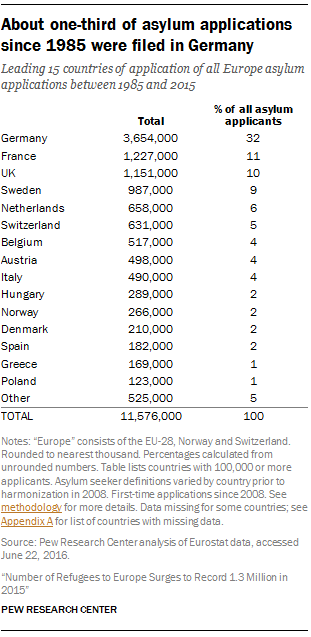
Of the 1.3 million asylum seekers entering the European Union, Norway and Switzerland in 2015, over half applied for asylum in just three countries: Germany, Hungary and Sweden. Among these three nations, Germany received more asylees than the other two combined and retained its status as Europe’s leading destination for asylum seekers – a distinction it has held since 2012.
Germany received about a third (or 442,000) of Europe’s asylum applications in 2015. This was well over twice as many applicants as it received in 2014 (174,000).
Finland, however, had the largest annual increase in asylum applicants of any EU country. The number of asylum seekers increased more than 800%, from more than 3,000 in 2014 to 32,000 in 2015. Meanwhile, Hungary also saw a rapid rise in the number of asylum seekers, more than quadrupling from 41,000 in 2014 to 174,000 in 2015.
In 2015, about 12% (156,000) of all of Europe’s asylum seekers applied in Sweden, making it the third-ranked country in the number of asylum applications received. Asylum seekers have increasingly gone to Sweden in recent years to apply for asylum. Overall, roughly one-in-ten asylum seekers have applied in Sweden each year during the past decade. And, it was the leading destination of unaccompanied minors in Europe in 2015.
The UK and France are no longer leading asylum seeker destinations

Prior to 2000, Germany annually had more asylum applications than any other European country – a pattern extending back, uninterrupted, to 1985. These asylum seekers were from a range of countries, and many came from other European countries after the collapse of the Eastern Bloc in the early 1990s and the destabilization of the former Yugoslavia in that decade. For several years in the 1980s and 1990s, Germany’s annual share of asylum applications was roughly half or more of all of Europe’s asylum applications.
A temporary shift in the leading countries of application occurred in the early 2000s. In 2000, 2002 and 2003, the UK became the leading destination country of asylum seekers in Europe, many of whom came from Iraq and Somalia. Between 2004 and 2011, France was often the leading destination. Many of these asylum seekers came from the Democratic Republic of the Congo, Haiti, Russia, Turkey and countries of the former Yugoslavia.

Germany resumed its previous spot as the leading recipient of asylum applications in 2012, largely due to the growing number of asylum seekers from other European countries such as Kosovo, Russia and Serbia as well as countries such as Afghanistan, Iran, Iraq, Pakistan and Syria.
It is notable that the share of asylum seekers more recently applying in Germany is more on par with the shares of asylum applications for Germany prior to 2000. 3 Since 2013, Germany received more than a quarter of annual asylum seekers in Europe. France and the UK never had a quarter or more of Europe’s annual asylum applications when they were the leading countries of destination.
Germany is the largest recipient of asylum applications since 1985
When summed together for all years between 1985 and 2015, nearly one-third (more than 3.6 million) of Europe’s asylum applications were registered in Germany. And since 1985, the UK and France each received about one-in-ten (or more than 1 million) of Europe’s asylum applications.
Countries with smaller resident populations such as Sweden, the Netherlands, Switzerland and Belgium also each received hundreds of thousands of asylum applications between 1985 and 2015.




